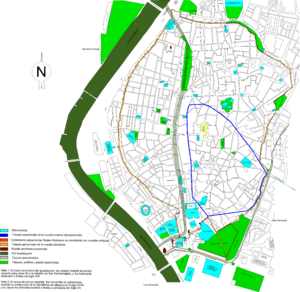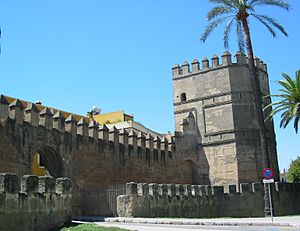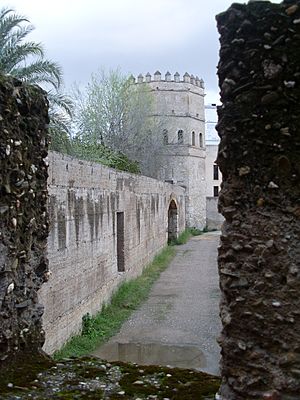Walls of Seville facts for kids
Quick facts for kids Walls of Seville |
|
|---|---|
| Native name Spanish: Murallas de Sevilla |
|
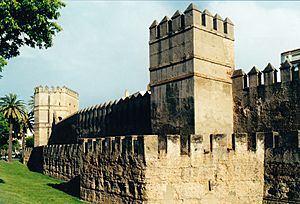 |
|
| Location | Sevilla, Spain |
| Official name: Murallas de Sevilla | |
| Type | Non-movable |
| Criteria | Monument |
| Designated | 1908 |
| Reference no. | RI-51-0000093 |
| Lua error in Module:Location_map at line 420: attempt to index field 'wikibase' (a nil value). | |
The Walls of Seville (in Spanish: Murallas de Sevilla) are old defensive walls. They surround the historic center of Seville, a city in Spain. These walls have protected Seville for a very long time.
The city has had walls since the Roman times. Over the years, different groups like the Visigoths, Muslims, and Castilians rebuilt and changed them. The walls stayed mostly complete until the 1800s. After a big change in Spain in 1868, many parts were taken down.
Today, you can still see parts of these ancient walls. They are especially visible around the Alcázar of Seville, a royal palace. You can also find sections in the Macarena neighborhood.
The walls once had 18 gates or entry points. Four of these gates are still standing today: Puerta de la Macarena, Puerta de Córdoba, Postigo del Aceite, and Postigo del Alcázar. The parts of the walls that remain look mostly like they did during the Almohad period. Some parts also show changes from the 1700s.
Contents
History of Seville's Ancient Walls
Building Walls in Roman Times
The first defensive walls were built around 68 to 65 BC. This was when Julius Caesar was a leader in the city. These new stone walls replaced older ones made of logs and mud.
Later, under Caesar's adopted son, Augustus, the walls were made even bigger. This happened because the city grew a lot. These Roman walls had strong, giant towers to protect them. Today, you can only see parts of these Roman walls. They were reused in later constructions, especially in the Alcázar of Seville walls.
Expanding Walls in the Islamic Period

During Islamic rule, the walls faced challenges. In 844, Vikings attacked Seville and burned down the walls. After this, Emir Abderramán II ordered the walls to be rebuilt. However, his great-grandson, Abd-ar-Rahman III, later destroyed them again.
In 1023, Abu al-Qasim, the first king of the Taifa of Seville, rebuilt the walls once more. He wanted to protect the city from Christian armies. Between the 11th and 12th centuries, the walls were greatly expanded. The protected area of the city almost doubled in size.
The rulers of Seville kept making their defenses stronger. This was important because Christian kingdoms to the north were growing. The final shape of the city walls came from these efforts.
The gates of Islamic cities were often built in a tricky way. They were angled, not straight, to make it hard for attackers to get in. Attackers had to go through several gates and courtyards. This gave defenders time to shoot arrows and pour boiling oil on them from above.
Walls After Christian Conquest: 13th-16th Centuries
In 1248, Ferdinand III of Castile conquered Seville for the Christians. The new rulers kept the walls mostly as the Muslims had built them. It was a tradition for new kings to swear their loyalty to the city at one of its main gates. This showed their power.
For example, Isabella I of Castile (in 1477) and Charles V, Holy Roman Emperor (in 1526) swore their oaths at the Puerta de la Macarena. Philip II (in 1570) did so at the Puerta de Goles, which was then renamed Puerta Real.
During the reign of Charles V, many of the main city gates were updated. They were made wider to allow carriages to pass through more easily. Gates like the Puerta de Carmona and Puerta de la Carne were changed. The Postigo del Aceite also saw improvements. Some gates, like the Puerta de Triana, were even moved to new locations.
Walls in Later Years: 17th-19th Centuries
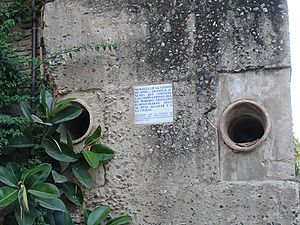
Over time, the walls became less important for military defense. Instead, they helped protect the city from Guadalquivir river floods. They also had a role in trade. The walls acted like a customs checkpoint, controlling who and what entered the city. People had to pay taxes on goods passing through. This helped the city collect money. The walls also helped control diseases by limiting who could enter.
In the 1700s, some gates were remodeled. The Puerta del Arenal was rebuilt. A small chapel was added to the Postigo del Aceite. The Puerta de San Fernando was also built.
By 1836, the walls were still mostly complete. A moat and drawbridge were even added near the Puerta de la Macarena to make it stronger. However, after the revolution of 1868, much of the walls were torn down. This was mainly because the city needed to grow.
Some parts of the walls were saved. These include sections in the Macarena neighborhood, which still have seven square towers and one octagonal tower. Parts near the Puerta de Córdoba and the Alcázar also remain. Famous towers like the Torre Abd el Aziz, Torre de la Plata, Torre del Oro, and Torre Blanca are also preserved.
Gates and Entry Points of the City
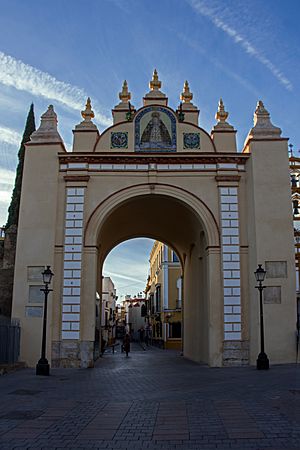
People entered Seville through gates (puertas) and smaller gates (postigos). There were 19 such entry points. The main gates often had angled entrances to make attacks harder. They usually did not have much decoration.
Here are some of the main gates and postigos:
- Main City Gates
- Puerta de la Macarena: This gate was built during the Almoravid period and updated in the 1700s. It is located opposite the Basílica de La Macarena.
- Puerta de Córdoba: Also from the Almoravid period, this gate was updated in the 1500s. It is one of the best-preserved original gates.
- Puerta de Carmona: An Almoravid gate, fully renovated in the 1500s. It was torn down in 1868.
- Puerta Real: This Almoravid gate was rebuilt in the 1500s. It was also called Puerta de Goles.
- Puerta de San Fernando: Built in the 1700s, this was the newest gate. It was located near the Royal Tobacco Factory.
- Puerta de Triana: An Almoravid gate, rebuilt in 1585 and torn down in 1868.
- Smaller Wall Gates (Postigos)
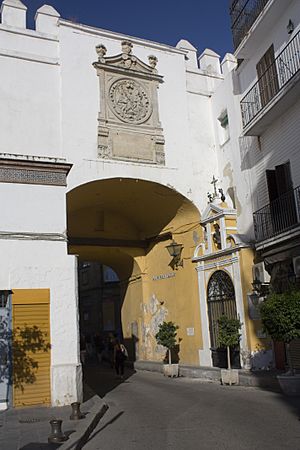
- Postigo del Aceite: This Almoravid postigo was much reformed. It was famous as the place where oil entered the city. It is near the Correos building.
- Postigo del Alcázar: This gate was built by the Almohads. It is located on Calle Judería.
- Postigo del Carbón: An Almoravid postigo that was moved in the 1500s.
Remaining Sections of the Walls
Macarena to Córdoba Section
This is the longest and best-preserved part of the walls. It includes the Puerta de la Macarena and the Puerta de Córdoba. The Puerta de Córdoba is the best-preserved gate from the Caliphate period. This section also has several towers, including the Torre Blanca.
Jardines del Valle Section
This is the second-longest section. It was once hidden inside a convent. After the convent was taken over by the government in the 1800s, the land became the current Jardines del Valle (Gardens of the Valley).
Alcázar Walls
The walls around the Alcázar are of different types:
- Some parts are made of large stone blocks, likely reused from the early Roman walls. You can see these near the Puerta del León.
- Other parts are mud walls built by the Almohads. Some are visible on Calle Judería and Calle Agua.
- There are also walls that enclose the Alcázar gardens, next to the Jardines de Murillo.
Torre Abd el Aziz Section
This is a small section of wall. You can see it inside a shop next to the Torre Abd el Aziz.
Postigo del Aceite
This is one of the three outer gates that still exist today.
Plaza del Cabildo Section
This is a small section of about 50 meters. You can see it from the plaza del cabildo and from the street behind it. It includes a tower.
Torre de la Plata Section
This section includes the start of the Postigo del Carbón. It also has parts of the walls that connected the Torre de la Plata with the Torre del Oro. In 2012, remains of a new tower from the late 1000s or early 1100s were found here.
Puerta Real Start
This is a small section of wall where Calle Alfonso XIII and Calle Goles meet.
See also
 In Spanish: Murallas de Sevilla para niños
In Spanish: Murallas de Sevilla para niños


